HP Z27q Monitor Review: Aiming For More Pixels
by Brett Howse on December 22, 2015 8:00 AM ESTsRGB Calibration
Calibration of the monitor is done with SpectraCal’s CalMAN 5 suite. For contrast and brightness, the X-Rite i1DisplayPro colorimeter is used, but for the actual color accuracy readings we use the X-Rite i1Pro spectrophotometer. Pre-calibration measurements were done at 200 nits for sRGB with Gamma set to 2.2. In addition, the display is also calibrated for 80 nits.
Grayscale
Out of the box, the grayscale could use some work. The white point is a bit warm, gamma is too high near 100%, and there are error levels over 3 at a couple of the measurement points. Overall the dE is just 2.5, which is reasonable, but anyone wanting to use this display for professional work is going to need to calibrate it.
Saturation
The saturation numbers are much better, which is good since the LUT is not adjustable. Overall the dE is just 1.7, which is very good, and none of the individual tests had an error over 3. You can see that the sRGB gamut is nicely profiled.
GMB
Gretag Macbeth is the most comprehensive test, which goes outside of the standard gamut and saturation tests, and includes many other important colors such as flesh tones. Once again the Z27q is very accurate, with an overall score of just 1.41, which should be plenty accurate for most people. In fact, the grayscale is a part of this test, and it would have pulled the score up even higher. This is a very good result.
200 cd/m2 Calibrated
Next, we use the CalMAN software to calibrate the display. Since this display does not have an accessible LUT, the video card LUT is the only one able to be calibrated. This fixes pretty much just grayscale, but in this case that is the only thing that really needs work anyway.
Grayscale
Once calibrated, the grayscale is almost perfect. The gamma curve is much closer to where it should be, and the overall error level averages just 0.82. The 100% level is better, but still not perfect, but other than that the other results are very much improved. The white point is also fixed with calibration.
Saturation
The improved white point also has a nice impact on the saturation sweeps, with an overall average error level of just 0.73.
GMB
The Gretag Macbeth test also sees a nice improvement, going to an average error level of 0.93, which is fantastic. There were a couple of the colors which spiked close to dE of 3, but overall this is a very accurate panel once calibrated.
80 cd/m2 Calibrated
Since the average office space may not calibrate just at 200 nits, we also run through the tests again at 80 nits calibrated to see if the panel is as accurate with the backlight lowered.
Grayscale
There are no issues once calibrated at 80 nits. The average error rate is just 0.82 again, matching the 200 nit score. White point and gamma are very good as well, although there is a slight bump in gamma close to 100% white level.
Saturation
The saturation score has even improved at 80 nits, coming in at just 0.51 dE2000 average. Please pardon the graph – there is a bug with our workflow for the 80 nit level for saturation.
GMB
Once again we can sum up the Z27q as a very accurate display, once calibrated. The built in LUT for sRGB is very accurate, with the Gretag Macbeth average dE2000 of only 0.56. Considering you can’t calibrate the LUT on your own, it is even more important that HP gets it correct at the factory, and it appears that they have done their homework.
Relative Color Comparator - Correct on bottom, displayed on top
I don’t really find the inaccurate grayscale to be a big issue out of the box. Anyone purchasing the monitor for professional work is going to be calibrating it anyway. Prosumers who are after a 5K panel and don’t have the software or hardware to do calibration will likely be happy with the out of the box results too, since they are fine for most people.


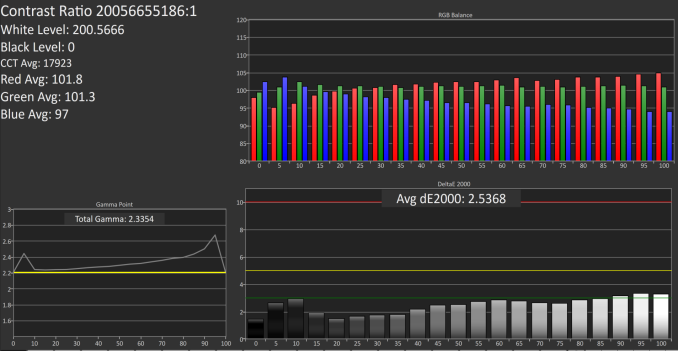
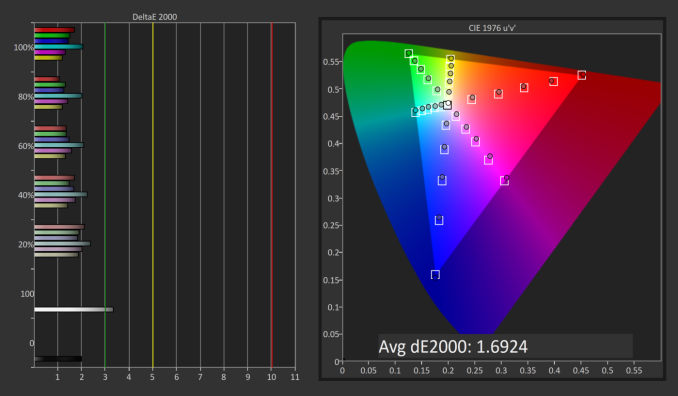
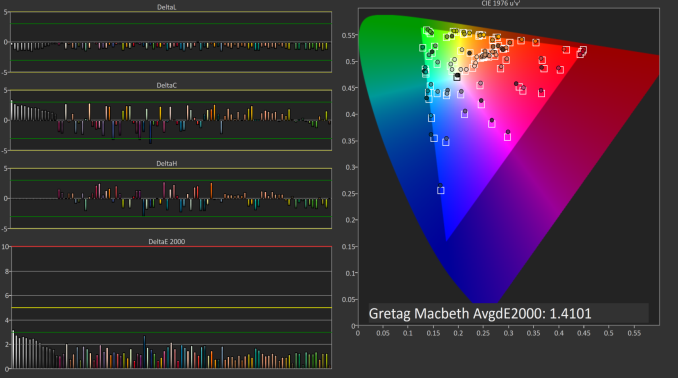
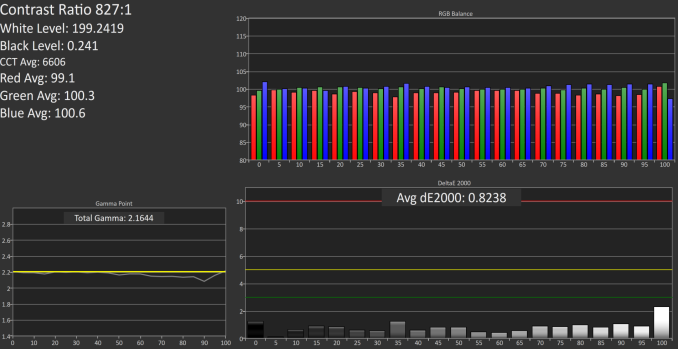
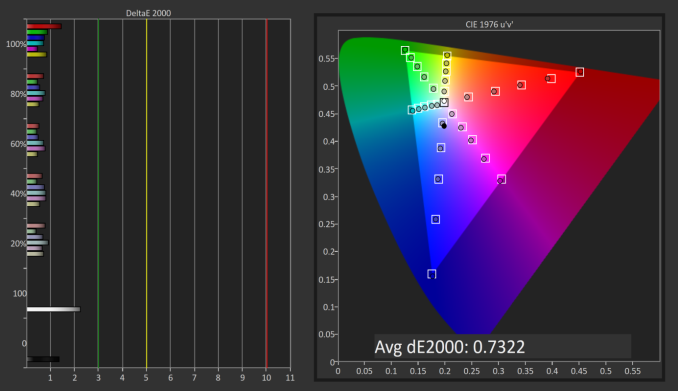
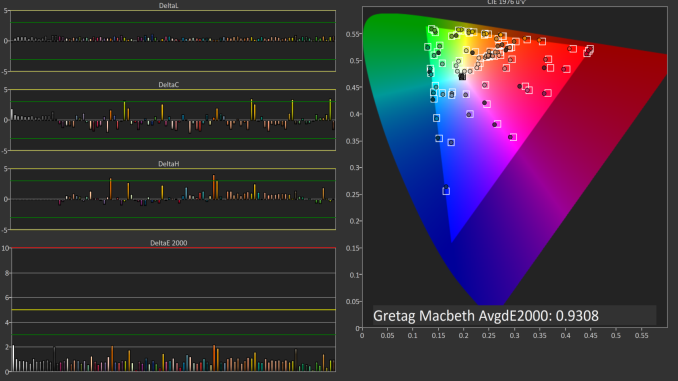
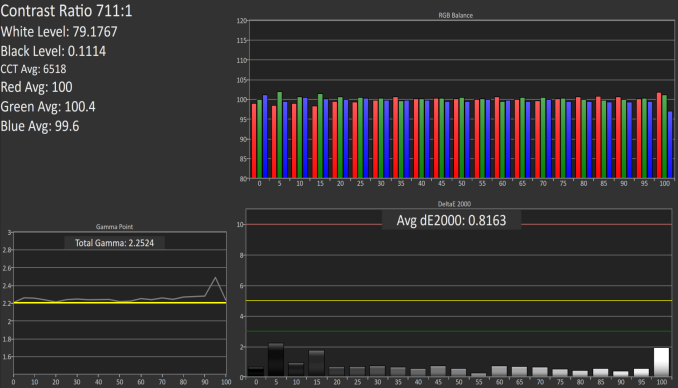
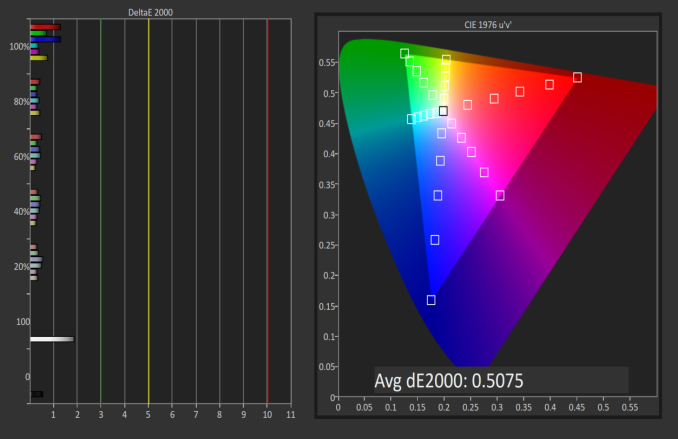
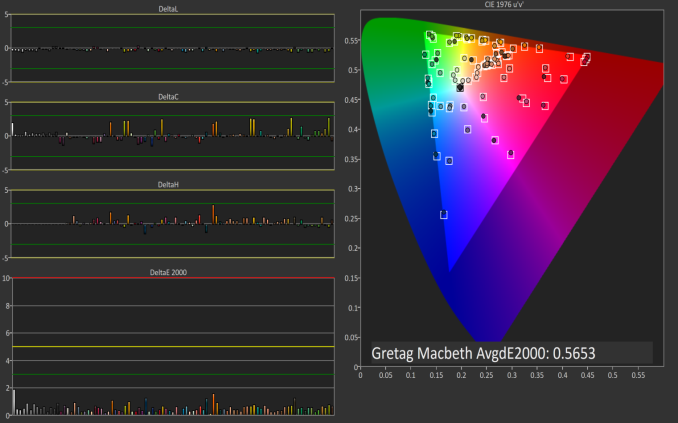










92 Comments
View All Comments
petteyg359 - Tuesday, December 22, 2015 - link
Why use software to do what hardware should be doing by giving me multiple screens?DanNeely - Tuesday, December 22, 2015 - link
Has there been any news about LGs 31.5" 5k panel (same height as 30" 1600p models) since the initial announcement in January. At that time, they were expecting panel production in Q3 of this year and initial retail availability around now, but I haven't seen anything since then.http://linustechtips.com/main/topic/289516-lgdispl...
BrokenCrayons - Tuesday, December 22, 2015 - link
It's pretty, but also pretty impractical. I just got an 18.5 inch replacement for my 15 inch monitor and it was hard to find one in that size at 1366x768 which is annoying since high resolutions just require scaling and end up only able to display the same amount of information at a cost of additional computation making the entire higher resolution thing a bit of an exercise in pointlessness. But aside from that, 27 inch screens are far too large for personal computing at a desk, forcing the user to push the screen away from their eyes in order to make effective use of it, once again defeating the purpose of scaling up the display. I'm already experiencing this moving up to an 18.5 inch screen. It's uncomfortable to use at the same distance so it had to move further away until it appears effectively the same size as my previous screen. The larger panel is therefore something of a waste as it's also too small to effectively serve as a conference room display. Overall, I'd say it's a very niche market and highly impractical screen. I'd be surprised if it makes many sales.Spunjji - Tuesday, December 22, 2015 - link
You're not on the side of the average consumer with your comments there, but this is definitely intended to be a niche product.Scaling is still useful, too. Text at the same size but rendered with more pixels is a lot more legible and pictures treated in the same manner look much more natural.
zodiacfml - Thursday, December 24, 2015 - link
5K is essentially for photo or high resolution video work. I have 15inch notebook with 1366x768 resolution and the pixels are pretty big and obvious. I can see it right now in this blue border of this Post your comment box. I have seen a 5K Mac display at close distance and the it reminds me of looking at a smartphone display in terms of PPI/sharpness.chaos215bar2 - Tuesday, December 22, 2015 - link
Is there a technical reason we aren't seeing the 5k equivalent of 30" monitors (5120x3200)? 27" 5k is nice, but this is a computer monitor, not a TV. Until monitors start seriously going beyond 27" (while maintaining pixel density), 16:9 really isn't an ideal aspect ratio for most work.DanNeely - Tuesday, December 22, 2015 - link
16:10 is dead, just as 4:3 died years prior. Being the same resolution as TVs certainly helped; that a 16:9 screen took less material and was therefor cheaper than a 16:10 one with the same diagonal size was probably the final nail in the coffin.theduckofdeath - Wednesday, December 23, 2015 - link
Agreed, 19:10 is for people who still full-screen all their apps, I think. 16:9 is more practical for side by side windows.theduckofdeath - Wednesday, December 23, 2015 - link
-3:p
okashira - Tuesday, December 22, 2015 - link
16 watts in standby? What a POS.